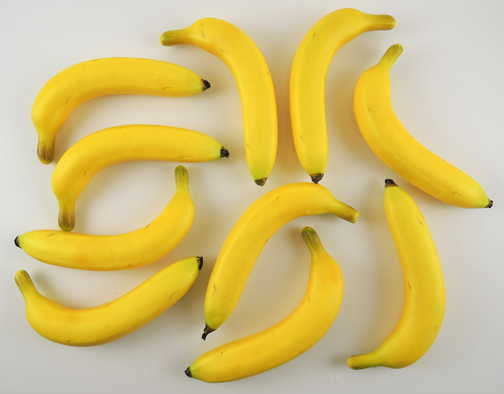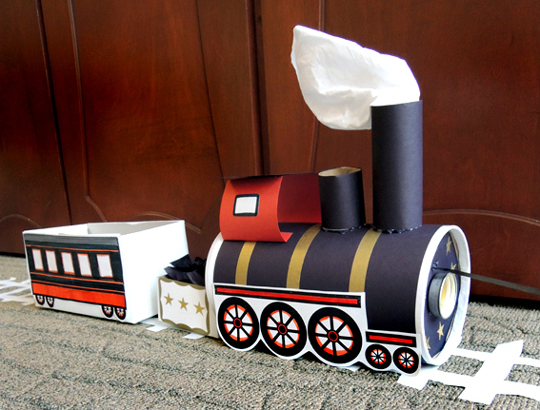 All aboard! This splendid stream engine pulls a passenger coach on masking tape tracks, making a number of stops to take on coal, water, and passengers before heading through a mountain tunnel!
All aboard! This splendid stream engine pulls a passenger coach on masking tape tracks, making a number of stops to take on coal, water, and passengers before heading through a mountain tunnel!
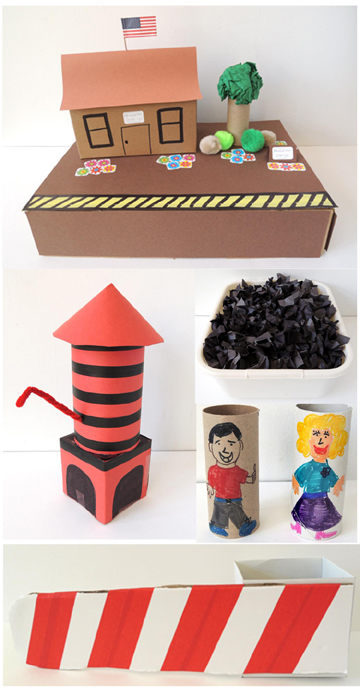 We read Chugga Chugga Choo Choo, written by Kevin Lewis, and illustrated by Daniel Kirk (Hyperion, 1999). A toy engine chugs through his day in the playroom, collecting freight, going through mountains, over bridges, across rivers, and finally relaxing in the roundhouse. Cleverly, the landscape is entirely made of toys (I especially like the bridge over the fish tank). It’s a sweet, simple story that was oft-requested in our household.
We read Chugga Chugga Choo Choo, written by Kevin Lewis, and illustrated by Daniel Kirk (Hyperion, 1999). A toy engine chugs through his day in the playroom, collecting freight, going through mountains, over bridges, across rivers, and finally relaxing in the roundhouse. Cleverly, the landscape is entirely made of toys (I especially like the bridge over the fish tank). It’s a sweet, simple story that was oft-requested in our household.
You’ll need:
- 1 large oatmeal container
- Construction paper, any color
- Construction paper, black
- A selection of color masking tape
- A box cutter
- 2 small craft sticks (mine were 3″ long)
- A 36″ piece of curling ribbon
- 1 small box (mine was 4” x 4” x 4” – a small tissue box works too)
- 2 name tag stickers with gold borders (optional)
- 1 engine wheels template printed on 8.5″ x 11″ white card stock
- 4 toilet paper tubes
- 1 drink lid
- 1 small l (optional)
- A selection of foil star stickers (optional)
- 1 tissue (i.e. Kleenex)
- 1 large box (mine was 4 ½” X 4 ½” x 9” but a large tissue box works too)
- 2 passenger car templates, printed on 8.5″ x 11″ pieces of white card stock
- Train track & stops (more on that later!)
- Scissors and tape for construction
- Markers for decorating
- Hot glue
Start with the engine! Wrap a 9″ x 11″ piece of construction paper (any color) around half of the oatmeal container. It won’t reach all the way around the container but that’s good. You want the uncovered section of the container to slide smoothly over the floor.
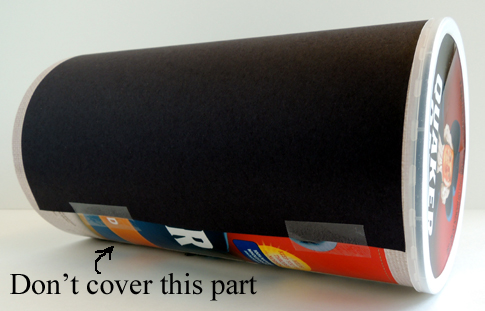 Use color masking tape to make three lines on the construction paper. Again, it’s best if they don’t go all the way around the container.
Use color masking tape to make three lines on the construction paper. Again, it’s best if they don’t go all the way around the container.
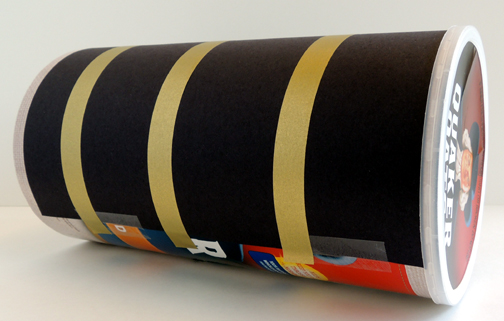 Cut a 4.5″ diameter circle out of black construction paper and use tape loops to attach it to the bottom of the container. Important! The bottom of the container is NOT the end with the lid. It is the plain cardboard end.
Cut a 4.5″ diameter circle out of black construction paper and use tape loops to attach it to the bottom of the container. Important! The bottom of the container is NOT the end with the lid. It is the plain cardboard end.
We’ll pause in exterior engine building for a moment to construct your train’s pull string. Hot glue two small craft sticks together in a cross. This creates the anchor for your pull string. Knot one end of curling ribbon around the anchor.
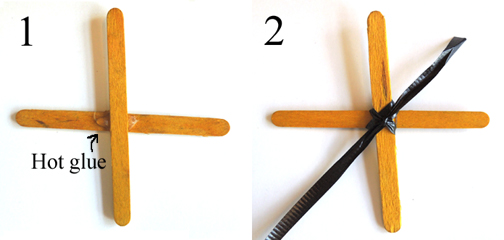 Next, use a box cutter to cut a small slit in the bottom of the oatmeal container, about 1.5″ from the top edge. This is where your pull string will come out.
Next, use a box cutter to cut a small slit in the bottom of the oatmeal container, about 1.5″ from the top edge. This is where your pull string will come out.
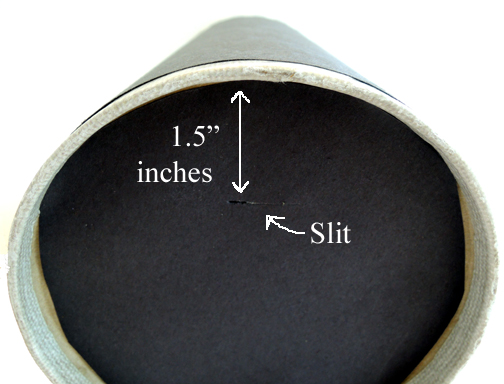 Use scissors to enlarge the slit. Then take the lid off the oatmeal container, reach inside, and poke the free end of the curling ribbon through the slit. Keep pulling the ribbon through until the anchor is snug up against the bottom of the container. Replace the lid and tape it closed.
Use scissors to enlarge the slit. Then take the lid off the oatmeal container, reach inside, and poke the free end of the curling ribbon through the slit. Keep pulling the ribbon through until the anchor is snug up against the bottom of the container. Replace the lid and tape it closed.
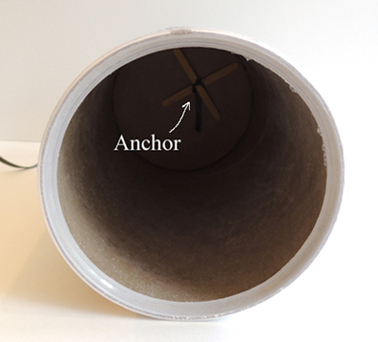 Now for the engine’s tender! Cut a small box down to 3″ high. Hot glue it to the lid of the oatmeal container and reinforce the connection with tape. Since this box is what keeps the oatmeal container from rolling around, make sure part of the box comes in contact with the floor, and that it’s really attached well.
Now for the engine’s tender! Cut a small box down to 3″ high. Hot glue it to the lid of the oatmeal container and reinforce the connection with tape. Since this box is what keeps the oatmeal container from rolling around, make sure part of the box comes in contact with the floor, and that it’s really attached well.
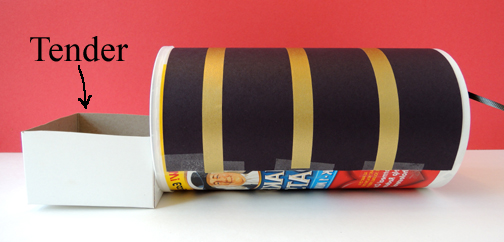 The engine’s cab is next. Fold the edges of a 3″ x 9″ piece of construction paper inwards to create two, 0.25″ folds:
The engine’s cab is next. Fold the edges of a 3″ x 9″ piece of construction paper inwards to create two, 0.25″ folds:
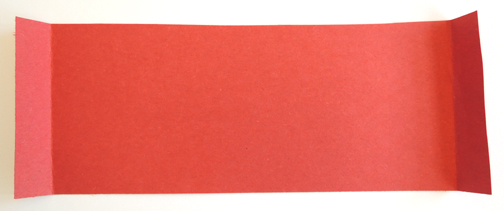 Curve the folds under and hot glue (or tape) them to the back of the engine (i.e. the end with the tender). Gently pinch the curvy top of the cab to make two more folds, giving the cab a flat roof.
Curve the folds under and hot glue (or tape) them to the back of the engine (i.e. the end with the tender). Gently pinch the curvy top of the cab to make two more folds, giving the cab a flat roof.
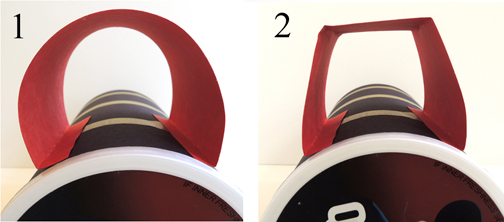 Hot glue (or tape) a 3.25″ x 3.25″ square of black construction paper to the roof of the cab. I also added some file label sticker windows. You can do this, or draw the windows on with markers. You can see the finished cab in the image below.
Hot glue (or tape) a 3.25″ x 3.25″ square of black construction paper to the roof of the cab. I also added some file label sticker windows. You can do this, or draw the windows on with markers. You can see the finished cab in the image below.
For your engine’s chimney (or “stack” as they sometimes call it) wrap a toilet paper tube with black construction paper and hot glue it to the top of the engine. Cut a second toilet paper tube down to 2″ and wrap it with black construction paper. This is your engine’s “dome”. Hot glue it behind the chimney. Tape a piece of tissue inside the chimney for smoke. 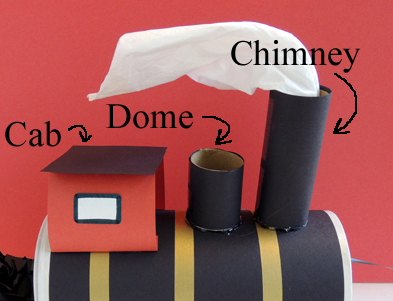 Color and cut out the engine wheels template. Hot glue (or tape) them to the sides of the engine. Crumble up some pieces of black construction paper to make “coal” for your tender. I added some gold-bordered name tag stickers to the sides of the tender, along with some gold foil stars.
Color and cut out the engine wheels template. Hot glue (or tape) them to the sides of the engine. Crumble up some pieces of black construction paper to make “coal” for your tender. I added some gold-bordered name tag stickers to the sides of the tender, along with some gold foil stars.
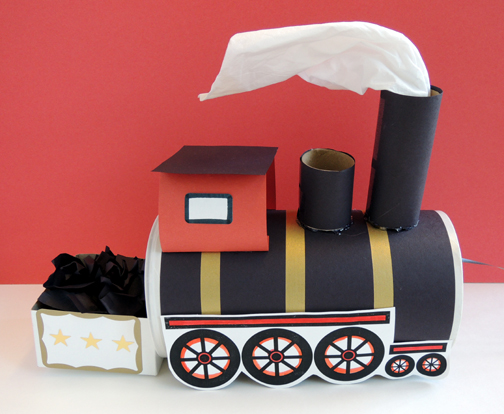
Finally, hot glue a drink lid to the front of the train for a light (we stuck a gold foil seal inside it for some extra shine). We added some gold foil stars to the front of the engine as well (whoops, I didn’t put the chimney on exactly straight did I?).
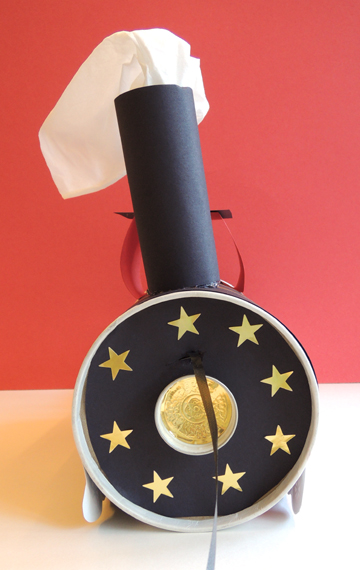 For the passenger car, simple color and cut the passenger car templates and hot glue (or tape) them to the sides of a large box. Some kids cut the lid off their boxes, and some left the lid intact. Totally up to you! Just don’t let the wheels of the train car extend past the bottom of the box, or it won’t slide on the floor!
For the passenger car, simple color and cut the passenger car templates and hot glue (or tape) them to the sides of a large box. Some kids cut the lid off their boxes, and some left the lid intact. Totally up to you! Just don’t let the wheels of the train car extend past the bottom of the box, or it won’t slide on the floor!
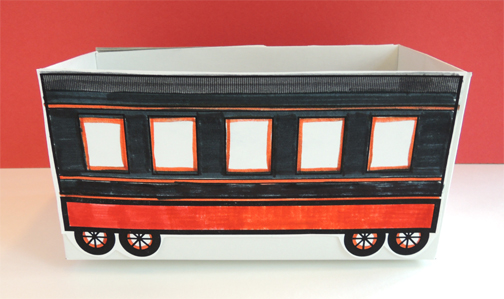 To couple your passenger car to your engine, cut two, 15″ pieces of masking tape (I used black masking tape, but any color will do). Lay one piece on top of the other, with the sticky sides facing each other. Hot glue this masking tape “strip” to the bottom of the train. Make sure to leave a 1.5″ gap between the tender and the passenger car.
To couple your passenger car to your engine, cut two, 15″ pieces of masking tape (I used black masking tape, but any color will do). Lay one piece on top of the other, with the sticky sides facing each other. Hot glue this masking tape “strip” to the bottom of the train. Make sure to leave a 1.5″ gap between the tender and the passenger car.
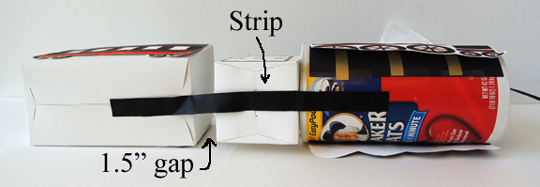 Your train is done! You can stop there, or you can go a step further like we did and make a track and “stops” for the train. If you’re up for that, read on…
Your train is done! You can stop there, or you can go a step further like we did and make a track and “stops” for the train. If you’re up for that, read on…
For the tracks, use masking tape to make the two rails. Then connect the rails with more masking tape “ties.” It’s simple to do, but it takes time. Especially because we laid a whole lotta track all over the gallery (just look at the tape blob that resulted from clean up)! Here’s Katie, who is, quite literally, “working on the railroad.”
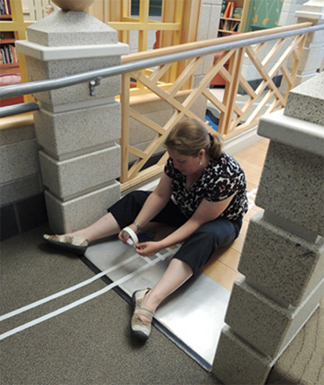 Next, Katie made a couple different elements for the railroad: a station (a copy paper box lid with a box station and some accoutrements); a water tower (a small oatmeal container, a small box, some construction paper, and a pipe cleaner); a big container of extra coal (little crumbled up pieces of black construction paper); a couple of toilet paper tube passengers (I’ve named them George and Martha); and a crossing gate (white cardboard wrapped with red masking tape hot glued to a box).
Next, Katie made a couple different elements for the railroad: a station (a copy paper box lid with a box station and some accoutrements); a water tower (a small oatmeal container, a small box, some construction paper, and a pipe cleaner); a big container of extra coal (little crumbled up pieces of black construction paper); a couple of toilet paper tube passengers (I’ve named them George and Martha); and a crossing gate (white cardboard wrapped with red masking tape hot glued to a box).
 The morning of story time, I made the tunnel. It was 2 huge pieces of cardboard taped to the railings of our gallery bridge. Once they were secured, I covered them with a brown sheet.
The morning of story time, I made the tunnel. It was 2 huge pieces of cardboard taped to the railings of our gallery bridge. Once they were secured, I covered them with a brown sheet.
 Ready to see the whole route in action? At the starting line, Katie shoveled extra coal into each engine’s tender. Then the trains were off, chuffing down the track!
Ready to see the whole route in action? At the starting line, Katie shoveled extra coal into each engine’s tender. Then the trains were off, chuffing down the track!
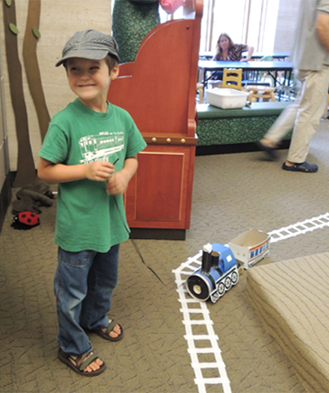 The first stop was the water tower, where kids pushed two blue cotton balls into the train’s dome to feed the boiler.
The first stop was the water tower, where kids pushed two blue cotton balls into the train’s dome to feed the boiler.
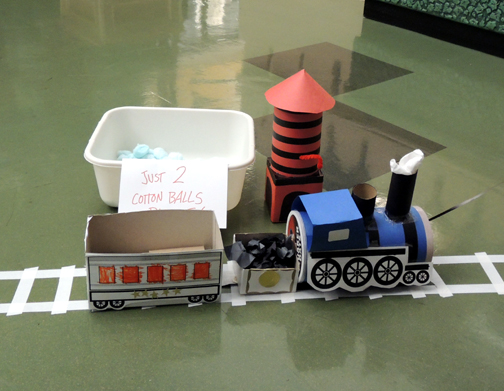 Next the train encountered a crossing gate. I was operating this particular mechanism (I do a very convincing “ding ding ding ding”).
Next the train encountered a crossing gate. I was operating this particular mechanism (I do a very convincing “ding ding ding ding”).
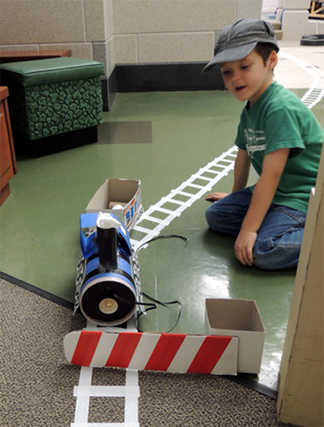 After that, the trains headed around a long bend to the station, where kids loaded 2 toilet paper tube “passengers” into their passenger car (we had a bin sitting nearby with extra tubes for them to take home and color in later).
After that, the trains headed around a long bend to the station, where kids loaded 2 toilet paper tube “passengers” into their passenger car (we had a bin sitting nearby with extra tubes for them to take home and color in later).
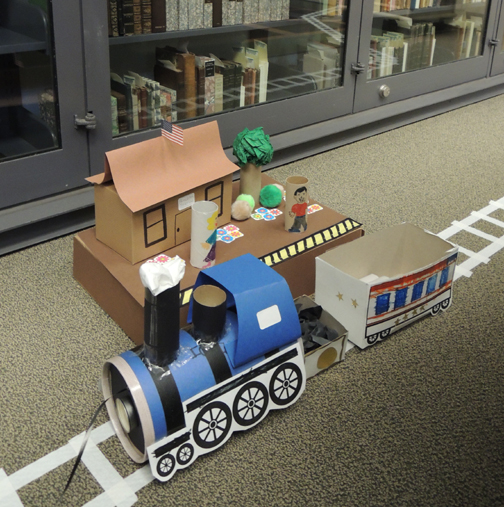 Then it was off to the mountain tunnel. I made sure that the train route would lead kids uphill in the tunnel (because it’s hard for kids to navigate, stare at a train, and duck into a tunnel without also having to balance downhill).
Then it was off to the mountain tunnel. I made sure that the train route would lead kids uphill in the tunnel (because it’s hard for kids to navigate, stare at a train, and duck into a tunnel without also having to balance downhill).
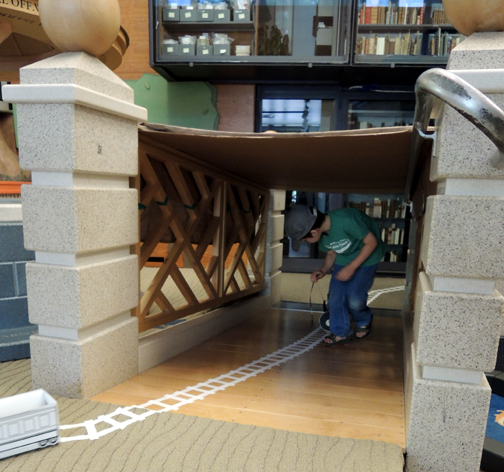 After the tunnel, it was a quick trip to the finish line. All the while, the little engineers were being serenaded by my Rare Books colleagues AnnaLee and Kelly, who performed a most excellent rendition of “I’ve Been Working on the Railroad.” THANKS LADIES!
After the tunnel, it was a quick trip to the finish line. All the while, the little engineers were being serenaded by my Rare Books colleagues AnnaLee and Kelly, who performed a most excellent rendition of “I’ve Been Working on the Railroad.” THANKS LADIES!
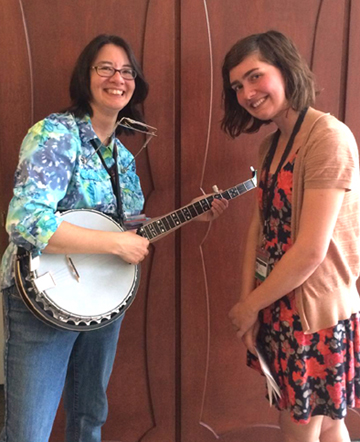
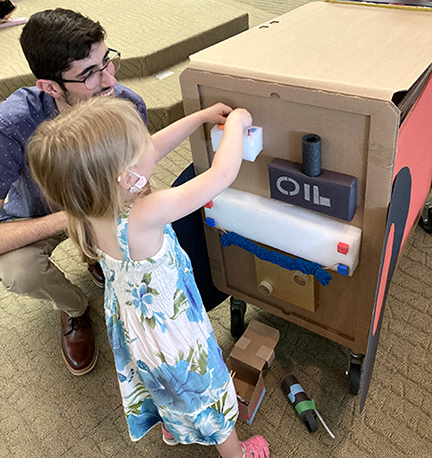 Is your story time tractor running a little rough? Maybe it’s missing a few foam bead plugs or yarn wires? Not to worry! With your handy-dandy toolbox and “can do” spirit, you’ll have everything working in no time!
Is your story time tractor running a little rough? Maybe it’s missing a few foam bead plugs or yarn wires? Not to worry! With your handy-dandy toolbox and “can do” spirit, you’ll have everything working in no time!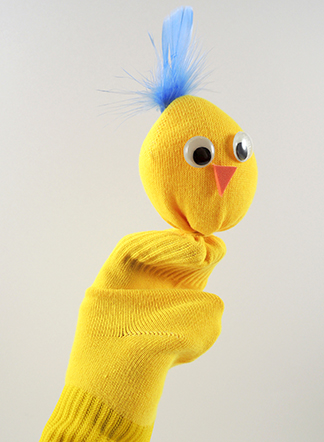 Notice when you place the sock on your hand, you can still use your thumb and fingers to grasp things? It’s an important detail that we’ll return to later! Next up is the tool box:
Notice when you place the sock on your hand, you can still use your thumb and fingers to grasp things? It’s an important detail that we’ll return to later! Next up is the tool box: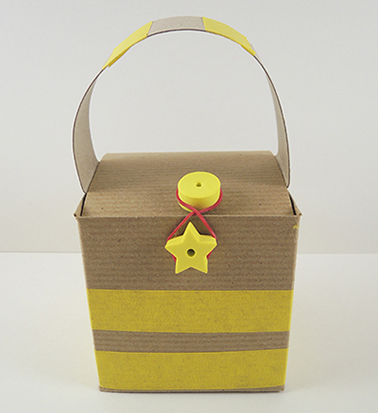 To make the box handle, tab both ends of 1.5″ x 11″ strip of poster board or tagboard, then attach the tabs to the underside of the box lid. Glue 1 foam bead on the top of the lid, and another on the front of the box. Wind a small rubber band around the beads to keep the lid closed while carrying. Decorate the tool box with markers (or use color masking tape like we did).
To make the box handle, tab both ends of 1.5″ x 11″ strip of poster board or tagboard, then attach the tabs to the underside of the box lid. Glue 1 foam bead on the top of the lid, and another on the front of the box. Wind a small rubber band around the beads to keep the lid closed while carrying. Decorate the tool box with markers (or use color masking tape like we did).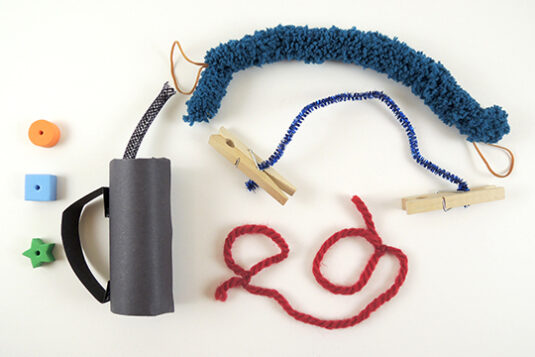 There are 3 foam bead bolts, 1 toilet paper tube oil can, and 3 different tubes and wires. The wires are made of yarn or sparkle stems and have rubber band or clothespin fasteners. All of these items are used to “fix” the engine of this AMAZING book cart tractor Katie constructed out of boxes, tubes, and poster board!
There are 3 foam bead bolts, 1 toilet paper tube oil can, and 3 different tubes and wires. The wires are made of yarn or sparkle stems and have rubber band or clothespin fasteners. All of these items are used to “fix” the engine of this AMAZING book cart tractor Katie constructed out of boxes, tubes, and poster board!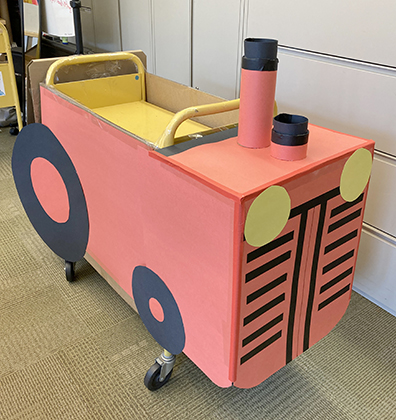 The back of the tractor flipped up to reveal the engine, which had parts missing. Kids then used the various items from their tool kits to repair it…all while wearing their chick hand puppet!
The back of the tractor flipped up to reveal the engine, which had parts missing. Kids then used the various items from their tool kits to repair it…all while wearing their chick hand puppet!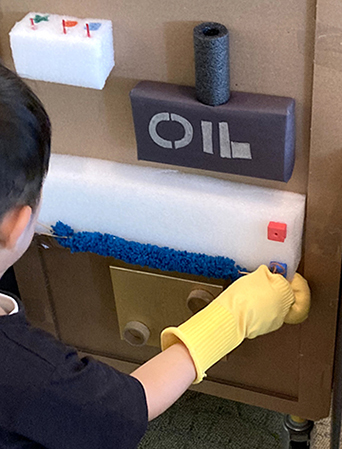 We constructed the tractor’s engine out of various upcycled boxes and materials (I especially love the mac & cheese box oil tank). You can also see how our tool box items fit on the engine below:
We constructed the tractor’s engine out of various upcycled boxes and materials (I especially love the mac & cheese box oil tank). You can also see how our tool box items fit on the engine below: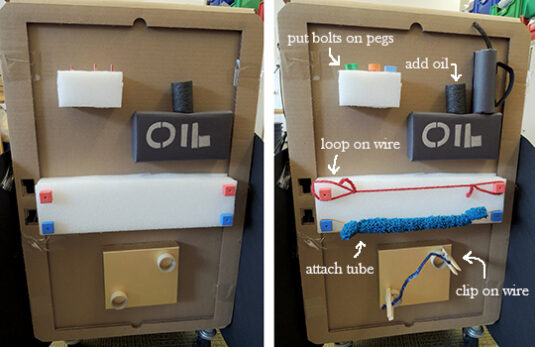

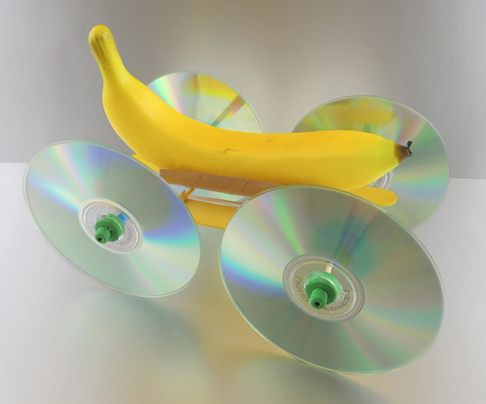 This banana’s going mobile, thanks to its CD wheels and rubber band engine! And why did we rig this fruit to roll? Four words: fusion, bananas, trolls, and technology. This feat of engineering was was constructed at
This banana’s going mobile, thanks to its CD wheels and rubber band engine! And why did we rig this fruit to roll? Four words: fusion, bananas, trolls, and technology. This feat of engineering was was constructed at 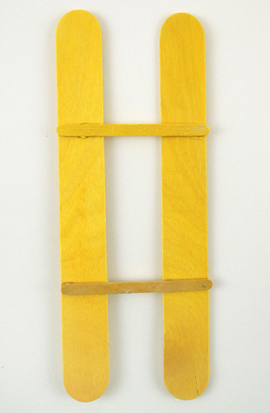 Next, cut a toilet paper tube in half, then hot glue it on top of the mini craft sticks:
Next, cut a toilet paper tube in half, then hot glue it on top of the mini craft sticks: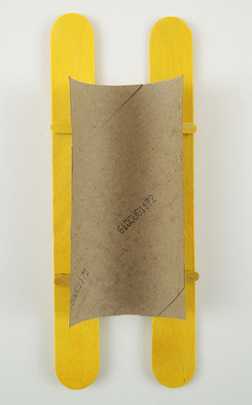 This creates your “banana saddle,” which keeps the bottom of your banana from interfering with the rubber band motor. Here’s a side view of the finished saddle:
This creates your “banana saddle,” which keeps the bottom of your banana from interfering with the rubber band motor. Here’s a side view of the finished saddle: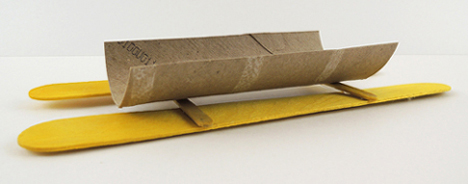 To create the rubber band motor, tightly wrap a brass fastener around the center of a 5.75″ piece of bamboo skewer. You want to prongs to be nice and tight, but make sure there’s still a little room under the head of the brass fastener for the rubber band.
To create the rubber band motor, tightly wrap a brass fastener around the center of a 5.75″ piece of bamboo skewer. You want to prongs to be nice and tight, but make sure there’s still a little room under the head of the brass fastener for the rubber band.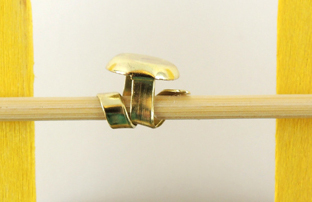 Cut a drinking straw into 3 pieces (two 1.5″ pieces, and one 3.75″ piece). Thread the 2 smaller pieces on either side of the bamboo skewer with the brass fastener. Then thread the larger straw piece onto the other bamboo skewer. Hot glue the straws directly to the jumbo craft sticks, then loop a rubber band onto the center of the longer straw. The underside of your car should now look like this:
Cut a drinking straw into 3 pieces (two 1.5″ pieces, and one 3.75″ piece). Thread the 2 smaller pieces on either side of the bamboo skewer with the brass fastener. Then thread the larger straw piece onto the other bamboo skewer. Hot glue the straws directly to the jumbo craft sticks, then loop a rubber band onto the center of the longer straw. The underside of your car should now look like this: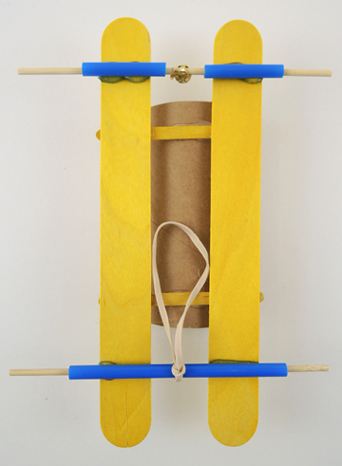 Later, you will wrap the rubber band around the head of the brass fastener, then wind the wheel and the axle to tighten the rubber band and prime the banana car’s “motor”:
Later, you will wrap the rubber band around the head of the brass fastener, then wind the wheel and the axle to tighten the rubber band and prime the banana car’s “motor”: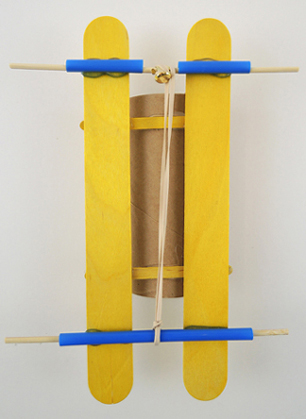 The car’s wheels are surplus CDs we obtained via donation from various University departments. We pushed a foam bead through the holes of each CDs, then hot glued them for extra security. Slide the wheels onto the ends of the bamboo skewers, then hot glue another foam bead to the outside of each wheel.
The car’s wheels are surplus CDs we obtained via donation from various University departments. We pushed a foam bead through the holes of each CDs, then hot glued them for extra security. Slide the wheels onto the ends of the bamboo skewers, then hot glue another foam bead to the outside of each wheel.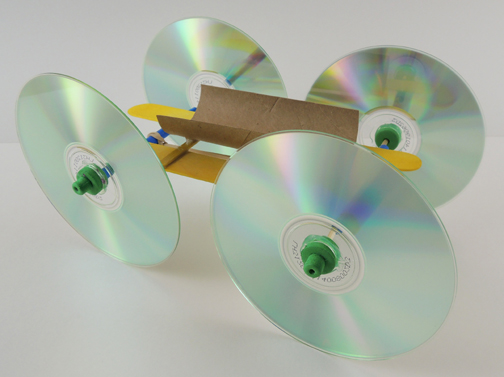 The car is ready to go…all you need is a banana! We actually went with FAKE bananas for this project (Amazon: 6 cost $11). Firstly, fake bananas don’t ripen inconveniently. Secondly, fake bananas are lighter, which meant that the cars would roll a little further.
The car is ready to go…all you need is a banana! We actually went with FAKE bananas for this project (Amazon: 6 cost $11). Firstly, fake bananas don’t ripen inconveniently. Secondly, fake bananas are lighter, which meant that the cars would roll a little further.